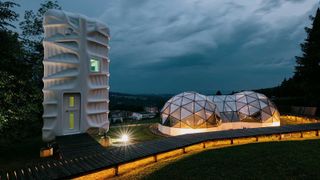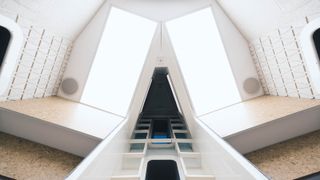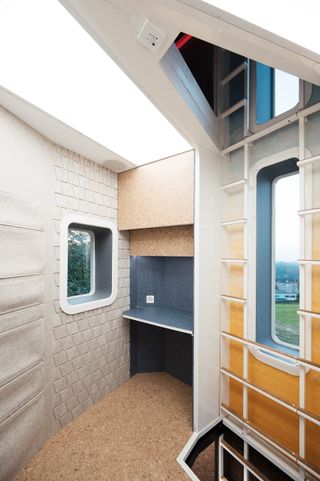Wild 3D-printed space habitat prototype designed to fit inside SpaceX Starship lands in Switzerland
SAGA Space Architects partnered with school-aged Swiss students to bring a light-infused look to moon or Mars exploration.

Perched in a Swiss experimental park is a space habitat inspired by SpaceX's Starship.
School-aged students at Institut auf dem Rosenberg, between ages 6 and 18, worked for years on a prototype for future astronauts that would fit inside the shell of SpaceX's powerful Starship rocket.
The results, unveiled on Wednesday (July 20), show a light-infused structure created in partnership with Danish architecture firm SAGA Space Architects. The three-storey building includes dedicated spots for analog astronauts to work and relax.
Related: Newly discovered bacteria on space station could help astronauts grow plants on Mars
In the coming years, students will complete "immersive learning modules" inside of the habitat. They will work inside what is said to be the world's tallest 3D-printed polymer structure at a height of 23 feet (7 meters), the institute said in a statement timed to coincide with the 53rd anniversary of the first human moon landing.
"Our aim is to provide future leaders with early exposure to the question of advanced space exploration, allowing our students to approach and solve ... complex questions from a collaborative and holistic point of view," Bernhard Gademann, director general of Rosenberg, said in the statement.

The Rosenberg Space Habitat took two years to create from "initial creative concepts and paper models," the institute said. Industrial partners assisted, with the 3D-printed outer shell created in Milan and the interior structure made in Copenhagen.
Get the Space.com Newsletter
Breaking space news, the latest updates on rocket launches, skywatching events and more!
Using polymer in 3D printing was a deliberate choice, but somewhat unique, as "it provides more versatility than concrete that is used in most 3D printed structures." In anticipation of high ultraviolet (UV) radiation on the surface of the moon or Mars, the material does have a UV stabilizer to make it more durable. However, the habitat can also be broken down and the polymer reused to make a new structure if required.
Add-ons for student missions include a robot, called Spot, and multi-functional furniture allowing residents to make the most of cramped quarters.

Planned investigations, Rosenberg stated, will examine hardware, software, remote mission control systems and "sensory stimulation" including light, sound and smell. Students will also participate in projects meant to simulate "systems thinking" (how a a complex system interrelates between its parts) and to work in artificial intelligence.
Rosenberg added that they hoped the in-house investigations in their habitat would benefit future lunar explorers, as it will show students "not to fear new technology, but to embrace it and design it to its next generation."
Follow Elizabeth Howell on Twitter @howellspace. Follow us on Twitter @Spacedotcom or Facebook.
Join our Space Forums to keep talking space on the latest missions, night sky and more! And if you have a news tip, correction or comment, let us know at: community@space.com.

Elizabeth Howell (she/her), Ph.D., is a staff writer in the spaceflight channel since 2022 covering diversity, education and gaming as well. She was contributing writer for Space.com for 10 years before joining full-time. Elizabeth's reporting includes multiple exclusives with the White House and Office of the Vice-President of the United States, an exclusive conversation with aspiring space tourist (and NSYNC bassist) Lance Bass, speaking several times with the International Space Station, witnessing five human spaceflight launches on two continents, flying parabolic, working inside a spacesuit, and participating in a simulated Mars mission. Her latest book, "Why Am I Taller?", is co-written with astronaut Dave Williams. Elizabeth holds a Ph.D. and M.Sc. in Space Studies from the University of North Dakota, a Bachelor of Journalism from Canada's Carleton University and a Bachelor of History from Canada's Athabasca University. Elizabeth is also a post-secondary instructor in communications and science at several institutions since 2015; her experience includes developing and teaching an astronomy course at Canada's Algonquin College (with Indigenous content as well) to more than 1,000 students since 2020. Elizabeth first got interested in space after watching the movie Apollo 13 in 1996, and still wants to be an astronaut someday. Mastodon: https://qoto.org/@howellspace
